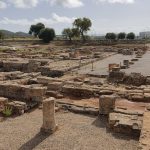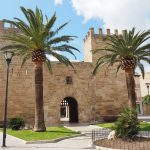Table of Contents
The historic Church of Sant Jaume is located in Alcudia, Mallorca. This historic church is one of the most iconic landmarks in the medieval walled city of Alcudia, giving visitors a glimpse into Alcudia’s rich culture & history.
With parts of the original 13th-century stone church still intact, this carefully preserved monument provides an architectural timeline spanning over 700 years.
This article delves into the long and storied history of Alcudia’s patron saint church, analyses its evolving Gothic-inspired architecture and design, showcases unique features like the dazzling 18th-century Baroque-style altarpiece, describes what visitors can expect when touring the church and museum, and provides practical tips for making the most of your visit.
Discover why so many visitors flock to admire this beautiful historic church at the heart of old Alcudia.
Get exclusive online discounts on all kinds of Majorca trips & activities
Historical Background
The Alcudia Church of Sant Jaume owes its existence to King Jaume II of Mallorca, who established the church in 1298, shortly after the founding of the town itself.
Positioning the new Gothic church within Alcudia’s monumental defensive walls emphasised its additional strategic purpose as a watchtower overlooking the Bay of Alcudia.
For centuries the church stood as a defensive stronghold monitoring incoming ships, while also functioning as a central hub for Catholic worship in Alcudia.
Over the next few hundred years as Alcudia’s population grew, the modest single-nave church expanded by adding side chapels. But by the 1800s, decades of inadequate upkeep caused the ageing church structure to deteriorate to a perilous state.
Most of the original medieval church tragically crumbled in 1870 due to torrential rains. Town authorities decided to construct a completely new church on the old foundation in a Neo-Gothic style, retaining and restoring a few surviving chapels. This ambitious reconstruction project was finally completed in 1893.
The parish museum located inside spotlights the church’s exceptional history with artefacts spanning over seven centuries, including remnants from the medieval Gothic church.
Visitors can admire this precious historical evidence first-hand by touring this captivating house of worship.
Architecture and Design
Rising from the site of Alcudia’s original patron saint church, the gleaming white Neo-Gothic facade displays the 19th-century rebuilding project’s attention to detail. Graceful arches, towering spires, and trefoil window tracery recreate the aura of a medieval Gothic cathedral.
But while emulating a historical aesthetic on the outside, inside the church clearly exhibits its 19th-century style with colourful stained glass windows and elegant ribbed ceiling vaults.
Splendid Neo-Gothic touches like the regal bishop’s throne displayed on the sanctuary’s rear wall provide elegant accents to the bright and inviting nave space. Some surviving aspects from previous iterations remain visible too, like the sandstone Gothic archway framing the Baptistery’s marble baptismal font.
Visitors can spot fascinating combinations of old and new architectural styles throughout this skillfully restored historic church.
But the dazzling highlight awaits in the elaborate golden altarpiece by local Majorcan sculptor Llorenç Ferrer Martí from 1893. This brilliant example of Baroque art gloriously spotlights the patron saint, Sant Jaume, recalling similar altars found in the great cathedral and churches of Palma de Mallorca.
Flourishing sculpted vines intertwine around this ornately carved wooden altarpiece stretching nearly to the decorated vaulted ceiling. The overwhelming decorative details keep visitors’ eyes endlessly wandering to uncover another tiny treasure.
Exhibits and Collections
Beyond the resplendent nave and mesmerising altarpiece, the Church of Sant Jaume’s small yet fascinating museum displays sacred artefacts providing a unique glimpse into Alcudia’s long religious history.
Golden reliquaries, medieval paintings, antique vestments, sacred documents, and many other precious items fill this carefully curated exhibit.
One intriguing display features the fragments of carved stone tracery salvaged from the original Gothic church’s arched windows prior to its collapse in 1870. Visitors can admire the meticulous stonemasonry skills utilised to produce these fragile ancient works of art.
Visitor Experience
Despite the Alcudia Church of Sant Jaume’s small size compared to Palma de Mallorca’s sprawling cathedral complex, visiting this monument still makes for an immersive cultural experience condensed into a very manageable and accessible site.
The museum’s chronological layout guides visitors on an easy self-guided walking tour from the church’s 13th-century Gothic origins to its present-day 19th-century Neo-Gothic reconstruction. Helpful informational signs provide insightful context but avoid overwhelming guests with excessive detail.
Visitors leisurely set their own pace while moving between the bright and inviting church nave to the more intimate museum rooms tucked away behind the main altar. Everyone receives a helpful pamphlet with maps and highlights in English to reference. Friendly local docents occasionally provide short impromptu talks when they notice interested visitors examining specific exhibits.
The museum also connects to the church balcony, which allows adventurous guests to gingerly ascend the narrow stone staircase leading to the restricted choir loft area. From this unique elevated vantage point, visitors gain a new perspective looking down upon the nave and altar. But the balcony’s tight space only comfortably accommodates a few visitors at a time.
Accessibility & Practical Information
Positioned close to the centre of Alcudia’s pedestrian-friendly medieval old town, the Church of Sant Jaume enjoys a prized location on the atmospheric Plaça de la Constitució ringed by charming restaurants with outdoor seating.
Visitors can easily access this site right off the main tourist route. Convenient street parking options exist close by too.
The church has free unticketed entry daily from 9 AM to 1 PM and again from 5 PM to 7:30 PM corresponding with major services.
Entry into the museum costs only €1 per person. Guided tours are not offered, but the museum still provides a quality self-guided experience with informational signs in English.
No strict dress code exists, but guests are kindly reminded to show appropriate reverent behaviour while inside this still actively functioning Catholic parish church.
Photography without flash is permitted everywhere except the balcony. Visitors should keep voices low within the church nave to avoid disturbing prayer and services.
The compact museum truly accommodates all visitors including families with strollers. A small yet modern wheelchair-accessible restroom also exists inside.
Unfortunately, no elevator reaches the quaint museum’s upper level or narrow church choir balcony, making those areas restricted to non-disabled visitors.
Local Surroundings and Attractions
As one of Alcudia’s most cherished landmarks, the Church of Sant Jaume finds itself surrounded by many other top area attractions. The church directly borders medieval defensive walls winding through Alcudia’s enticing old town.
Adventurous visitors can access stairs on the old ramparts beside the church to enjoy scenic views from these ancient fortified walls.
Just around the corner sits another must-see Alcudia attraction – the fascinating Roman ruins at the historic Pollentia site, which also includes an archaeological museum to explore.
Foodies flock to Alcudia’s bustling weekly open-air market held every Tuesday and Sunday only a short walk from the Church of Sant Jaume showcasing fresh local specialties.
This convenient old town location places quality restaurants and cafés within easy reach too. Visitors tend to especially enjoy relaxing at the laid-back tapas bars and bistros lining the pedestrian-only Carrer Major shopping street barely a block away.
The church also stays active hosting special events like the impressive Saint Christ procession held every November.
Personal Reflection
As an avid amateur historian, I find few activities more rewarding than losing myself for hours while exploring libraries, museums, and historic sites.
The Alcudia Church of Sant Jaume’s compact yet fascinating museum immediately captivated my imagination from the moment I began examining its treasures.
Pouring over the intricate designs or piecing together weathered stone fragments, I felt a powerful connection to the generations of worshipers who utilised these artefacts over many centuries.
My visit left me even more determined to focus part of my family heritage research on medieval Spain. Seeing such exquisite Spanish religious objects still intact after extensive turbulent history makes me eager to help document and preserve any artefacts my own ancestors may have created or owned now at risk of neglect or loss.
I cannot recommend a visit to the Alcudia Church of Sant Jaume highly enough for anyone else similarly passionate about history, architecture, art, or religion.
Just budget extra time to linger inside its small, but spectacular museum!
Conclusion
Whether you only have a spare hour to briefly admire Alcudia Church of Sant Jaume’s gleaming Neo-Gothic facade or dedicate half a day to fully immersing yourself within its museum’s incredible exhibits, visiting this hidden gem makes for an unforgettable Alcudia experience.
Designed intentionally for casual tourists and history buffs alike, the site balances showcasing impressive architecture with comprehensive cultural insights.
Beyond just snapshots for social media, a visit here tells an epic 700-year story about Alcudia itself – all conveniently encapsulated within an easily accessible historic landmark at the heart of the old town.
Location
Click to show map!

Mark Kaye is a travel writer and content creator living in Majorca, Spain. Originally from the UK, Mark moved to the island and quickly fell in love with Majorcan culture, food, and scenic landscapes. When he’s not busy writing detailed guides about Majorca’s top tourist attractions and hidden local gems, you can find him out exploring coastal trails or wandering the streets of Palma’s Old Town in search of his next great restaurant discovery.








